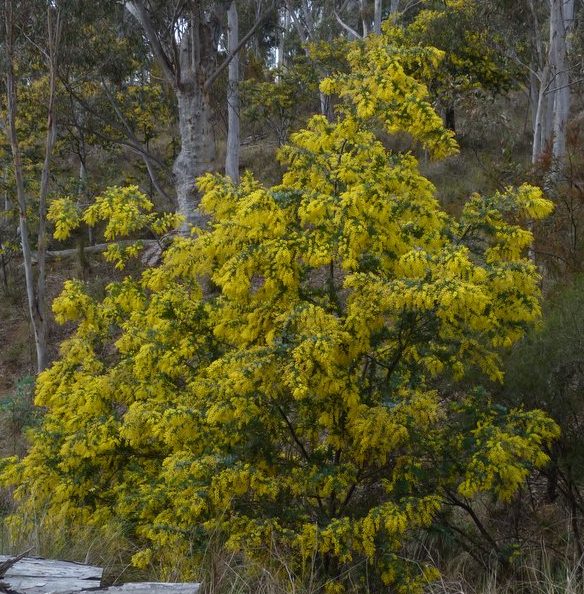
The flowers of Cootamundra Wattle can be so profuse that they almost hide the foliage. Photo: Ian Fraser.
In the last week of July we flew back from our first overseas trip in four years, three wonderful weeks of Central American warmth, forests and animals in Costa Rica.
It rained a lot too, so it was a revelation to drive home from the airport in clear sunshine – and to see that in our absence the wattles had turned the roadsides golden.
There were a few shrubs of a couple of local species among them, but the majority of the bright display was provided by a relative newcomer to Canberra, the Cootamundra Wattle (Acacia baileyana). Our first reaction was ‘They’re early!’, but I suspect that we say that nearly every winter, and I’ve learnt not to trust my memory in such things. (I would however be interested in your opinion on this – did they flower earlier than usual in Canberra this year?)
In its natural habitat, Cootamundra Wattle is restricted to a very limited range on the south-western slopes of New South Wales, in the Cootamundra – Temora area as we might expect. Its range extends for no more than 50 kilometres and, while there are stands in the Jindalee National Park, most of the naturally occurring plants are found on private land and along roadsides.

Superb Parrot eating Cootamundra Wattle pods at Mulligans Flat. Photo: Ian Fraser.
Given this, it might seem surprising that this pretty wattle, with its bluish-grey-green feathery foliage and bright yellow flowers in winter and early spring, should be perhaps the best-known wattle in Australia, at least by name. Indeed I’m going to suggest (admittedly without much evidence) that more people would recognise Cootamundra Wattle, both the name and the plant itself, than our national emblem, the Golden Wattle.
I’m sure that singer-songwriter John Williamson has a lot to do with this, but another important reason is that it is a very popular garden plant, for its hardiness and speed of growth. Moreover, it readily invades local bushland and in places has caused serious problems by forming dense stands in reserves and choking out species that more properly belong there.
It is regarded as a weed of concern in natural areas in Victoria, the ACT and the Blue Mountains, and I recall dense stands in the Mount Lofty Ranges above Adelaide.
Indeed, a quick look at the Atlas of Living Australia shows that it is established in moister areas of every Australian state and territory, though it is not regarded as a problem throughout that range. (I’m not suggesting that you shouldn’t grow it, though if you live near a reserve it might be wise to choose another option.) It is also well-established in California, New Zealand and South Africa.
The only local species that it could be confused with is Silver Wattle, but that flowers later (usually from September) and has different foliage. Each leaf of these wattles comprises pairs of feathery leaflets (pinnae) growing along the leaf stem. Cootamundra Wattle has only two to four of these pairs of pinnae, but Silver Wattle has many more of them.

Part of a stand of Cootamundra Wattle established on Black Mountain. Photo: Ian Fraser.
Its species name, baileyana, celebrates Frederick Manson Bailey, one of Australia’s most prominent botanists during the latter part of his life. He ran a plant nursery with his father until he was appointed Queensland Government Botanist in 1881. He collected throughout the state (his last expedition was to the Torres Strait when he was 72) and published the seven-volume Flora of Queensland, which to my knowledge has never been updated.
In the 1890s the government abolished the position but Bailey carried on working without pay until they relented, presumably embarrassed, and recreated the position. Reinstated, he filled it for the remaining 34 years of his life.
Indeed he was part of a dynasty of botanists who loomed large in the botanical landscape for much of the 19th and earlier 20th centuries. His father, John, was South Australian Colonial Botanist from 1839, and Frederick Manson’s son (also John), succeeded him as Queensland Government Botanist and went on to become Director of the Adelaide Botanic Gardens.
He in turn was succeeded in the Queensland job by a grandson, Cyril White – grandfather, son and grandson held the position continuously for some 70 years! Another grandson (yes, John) became curator of the Queensland Botanic Gardens.
OK, I’ve strayed a bit from the golden roadsides that caught our attention on our recent trip from the airport, but hopefully not enough to have lost you. There’s always a bit more to nature, and our relationships with it, than initially meets the eye. Say g’day to the next Cootamundra Wattle that brightens your day.















